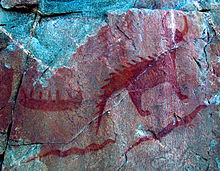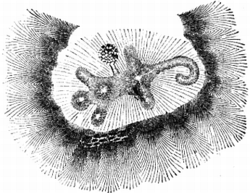Underwater panther
An underwater panther (Ojibwe: Mishipeshu (syllabic: ᒥᔑᐯᔓ) or Mishibijiw (ᒥᔑᐱᒋᐤ) [mɪʃʃɪbɪʑɪw]), is one of the most important of several mythical water beings among many Indigenous peoples of the Northeastern Woodlands and Great Lakes region, particularly among the Anishinaabe.
It has the head and paws of a giant cat but is covered in scales and has dagger-like spikes running along its back and tail.
[4] Some archaeologists believe that underwater panthers were major components of the Southeastern Ceremonial Complex of the Mississippian culture in the prehistoric American Southeast.
[10] In mythologies of the indigenous peoples of the Great Lakes, underwater panthers are described as water monsters that live in opposition to the thunderbirds,[12] masters of the powers of the air.
[11]: 60 Some traditions believed the underwater panthers to be helpful, protective creatures, but more often they were viewed as malevolent beasts that brought death and misfortune.
[12] As late as the 1950s, the Prairie Band of Potawatomi Indians performed a traditional ceremony to placate the Underwater Panther and maintain balance with the Thunderbird.
It was even worse to take it from the Great Lynx's home, Michipicoten Island; this was considered to be stealing from Mishipeshu himself.
[12] In 2003, archaeologist Brad Lepper suggested that the Alligator Effigy Mound in Granville, Ohio, represents the underwater panther.


